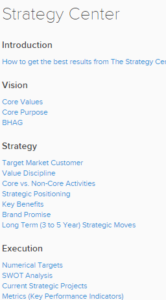Understanding the Context of Your Strategic Decisions
I have been in the privileged position of working with the Leadership Teams of many businesses to review their Strategic Plans, and in so doing, I’ve had the opportunity to help them set up, tweak and improve those plans. As the facilitator of those reviews, one of the main things I bring to the table is to ensure that the discussion and debate uses the correct context to drive decisions.
To create a powerful strategic plan, you need to make decisions in a specific order, because each decision you make sets up the context for the next decision. As you review each element of your strategy, you must do it with this context in mind.

When conducting Quarterly Strategic Reviews, Stephen Lynch, President of RESULTS, uses the picture above to explain the lens through which you review your SWOT analysis but I think it relates to your whole strategic plan.
Each person can only see part of the picture because they are looking through a narrow frame of reference. They each have a crucial part of the context, but not all of it. You have to take a step back in order to see the whole elephant and understand the bigger picture.
That’s why you need to make strategic planning decisions in order. We structure the RESULTS’ One-Page Strategic Plan in a specific order so that the whole picture is unveiled in a way that lets you produce your best work.
For example, it is important to have created your vision for the future before starting to decide on your strategic projects. Likewise, you can’t decide what your tactics for execution will be, or what your measurements of success are going to be, without first deciding what they are intended to accomplish.
It makes perfect sense that you can’t decide on what your 3 – 5 year strategic moves should be if you haven’t determined your ultimate long term goal.
The importance of ensuring that you have the right knowledge in the bank when making each subsequent decision is the rationale behind the order in which we approach our strategic planning in the order below:
Flipping The Plan
When helping businesses develop their strategy, a technique I use to create a solid thought process for making and reviewing decisions is to flip the plan upside down.
Firstly, when introducing an organisation to strategic planning for the first time it helps them to understand why it is important to follow a specific order and resist temptation to jump around. So let’s start flipping the plan.
Metrics or Key Performance Indicators (KPIs) come last. Why would we choose our KPIs last? KPIs are the metrics that, as individuals, we are accountable for moving forward and hitting targets for as an important part of our role. We will have chosen three categories of metrics: activity, effectiveness and outcome measures that let us know that we are being successful through what we do, how we are improving and what we deliver.
In other words, we need context. We can only know what we should be doing more of, what we should be doing better, and the results we should be delivering when the organisation knows the numeric targets that determine its success on a higher level.
The context of strategic decision making is very powerful when selecting your key strategic projects for the quarter and, as you’d expect, we recommend that you use your SWOT analysis as your context. I’d go as far as to say that a project can not be a strategic unless it directly impacts something in your SWOT analysis:Something can only be a strength if it is going to help us make the moves that will get us where we want to go
- Something can only be a weakness if, unless we fix it, it is going to prevent us from making the moves that will get us where we want to go.
Something can only be a opportunity if we need to pursue it to make a move that will get us where we want to go.
Something can only be a threat if it can derail our plans to make a move that will get us where we want to go.
One of the tasks that we conduct after we’ve chosen our three quarterly strategic projects is to allocate each one of them a colour. We then go through our SWOT and next to each element we place a coloured mark showing that the project has an impact on that aspect of the SWOT analysis. The more brightly coloured our SWOT, the more effective our projects should be. It is a powerful and enlightening exercise.
Of course, we have to put the SWOT analysis itself into context. We can only choose the elements of our SWOT analysis when we’ve chosen our three to five year strategic moves.
All the elements of your strategic plan cascade in this way. Each part should be discussed and debated in the light of previous decisions. So, before starting to create any element of your strategy ask yourself if you’ve got the context you need to make the right decisions.
Read more articles on Strategy, Culture and Key Performance Indicators here.


Recent Comments